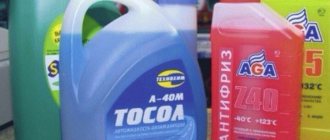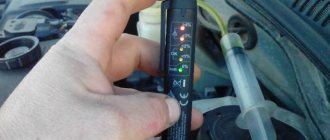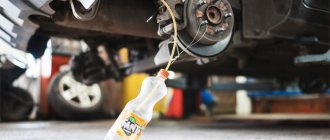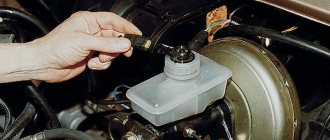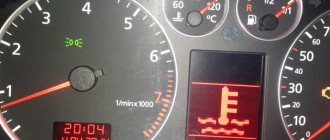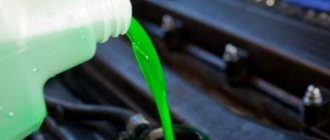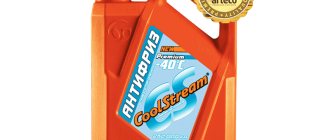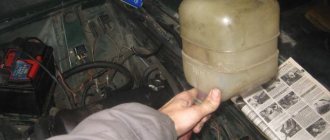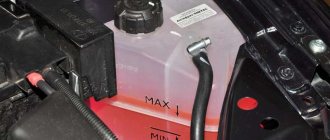In the summer, in cities and beyond, you can often see “boiling” cars. It often turns out that the engine began to knock due to a clogged radiator or a failed pump. In this case, one can only sympathize with the person who has to pay a decent amount for engine repairs only because he forgot that it is necessary to change the antifreeze in the car on time. In this article we will talk about when you should do this and what “alarm bells” can warn you about the risk.
Typical problems
Some novice motorists believe that horror stories associated with untimely replacement of antifreeze in the car are a marketing ploy by manufacturers. Yes, if you fill in the refrigerant with a slight delay, the risks of catching a wedge will be minimal. But there are other very real problems that many are not aware of. We have identified characteristic negative factors that appear when antifreeze is not replaced in a timely manner.
1. Overheating, interfering with the normal operation of the internal combustion engine
Normal engine operating temperature ranges from 85–90 °C. It is for this range that the clearances and materials of the power unit are designed. Overheating leads to a drop in power while simultaneously increasing fuel consumption. Insufficient cooling deforms the rings and cylinders. Increasing the gaps leads to exhaust gases entering the oil or grease into the exhaust manifold. If an internal combustion engine regularly operates above the standard temperature range, its service life is reduced by approximately 2–3 times.
2. Corrosive effects
The coolant contains a small amount of water (up to 5%). But antifreeze itself is highly hygroscopic. This means that even through contact with air it is able to absorb moisture. Consequently, over time, the refrigerant (namely the water in its composition) begins to provoke oxidative processes. Corrosion not only destroys the surfaces of the line and radiator. It reduces channel capacity and increases resistance. The corrosion layer has a lower thermal conductivity, which impairs the efficiency of the cooling system. All this creates extra load on the engine and heat-removing equipment.
3. Precipitation
This problem is typical for silicate-based antifreezes. Over time, some substances from their composition precipitate in the form of tiny silicon particles. As liquid circulates, the movement of solid components creates a significant abrasive effect.
4. Cavitation erosion
Cavitation refers to the natural process of formation of gas bubbles in a heated liquid. When these cavities collapse, significant energy is released, creating excess pressure in the vehicle's cooling system. In addition, bursting bubbles destroy metal surfaces, which leads to leaks. The new antifreeze contains special additives that minimize cavitation processes. But over time, the properties of the additives are lost.
5. System freezing
The high hygroscopicity of antifreeze leads to a constant increase in the concentration of water in the composition. This gradually lowers the coolant freezing threshold. If the water in the system crystallizes, then the tank, line elements, radiator and pipes suffer from expansion.
Now there should definitely be no doubt that it is necessary to regularly monitor the quality and condition of the coolant.
You may be interested in: How often do you need to add antifreeze?
Useful tips
Let's summarize the information about replacing antifreeze:
- add the liquid that is already filled into the system - the ideal solution is the composition recommended by the manufacturer;
- do not focus only on the color of the antifreeze - the shade itself cannot provide a complete guarantee that the antifreeze is of one type or another;
- do not mix compounds with different technical properties - this will provoke cavitation processes, metal corrosion will begin, which will inevitably lead to engine overheating.
And be sure to pour new fluid into the tank as slowly as possible, using a funnel - if the stream is strong, air will enter the system.
Every driver can replace antifreeze in his car, regardless of experience. On the other hand, he must know how often to do this, act strictly according to the instructions, thoroughly flush the system and refill with the recommended compounds. Recently, many people entrust this operation to service centers, since they do not have enough time to do the work themselves.
How often to change antifreeze in a car
| Group | Replacement period | Mileage |
| G11, Antifreeze | 2 years | 90 thousand km |
| G12, G12+, G12++ | 5 years | 150 thousand km |
| Multifreeze | up to 10 years | 250 thousand km |
This is a question many motorists ask themselves. But there is no universal correct answer for all cases. Experienced experts do not even advise relying entirely on the recommendations of the car manufacturer. The regulations indicate average recommendations that do not take into account operating conditions and quality of service. For example, there are years when in summer the air temperature during the day stays above 40 °C for a long time. If during such periods the car is actively used, then the antifreeze quickly loses its qualities. The condition of the cooling system lines at the time of filling the refrigerant is also important.
How often to change antifreeze in a car.
This depends on the make of the car, since different car manufacturers have their own recommendations on this matter.
| Car make | Antifreeze replacement frequency | Peculiarities |
| BMW | every 4 years | |
| Ford | once every 10 years | |
| G.M. | no need to change at all | |
| Hyundai | 10 years after purchase or if the mileage has reached 240,000 km | after 10 years, changes every 2 years |
| Kia | every 8 years | |
| Mazda | no need to change at all | not required during the entire life of the machine |
| Mercedes | every 5 years | |
| Mitsubishi | every 4 years | |
| Nissan | after 5 years | after 5 years changes every 3 years |
| Renault | in 6 years | relevant only for Reno Logan, Duster and Sandero; in many models replacement is not required at all |
| Skoda | after 6 years of operation | |
| Toyota | after 8 years of operation | after 8 years, changes every 4 years |
| Volkswagen | no need to change at all | It is recommended to change the fluid every 5 years, although the manufacturer says this is not necessary |
| AvtoVAZ | every 5 years | every 5 years for new models, and every two years for old ones |
Whether the coolant needs to be replaced and how often to change the antifreeze depends not only on the make of the car, but also on its mileage and the type of composition used. Approximate framework for how many kilometers it is necessary to fill in new coolant
Antifreeze and products of category G11.
These are traditional antifreezes with an inorganic composition. They usually contain a large amount of additives and are suitable for older car models or engines made of aluminum, cast iron and aluminum alloys. At what mileage should I change them? Approximately every 50–60,000 km. For new AvtoVAZ models, this figure can be up to 75,000 km.
Antifreeze class G12.
These are carboxylate compounds with organic additives. Their base is ethylene glycol, but the additives contain carboxylic acid. Such substances should be replaced every 120,000 km.
Hybrid formulations.
These may include antifreezes of the G12 category with varying numbers of advantages. They mix organic and inorganic substances, which is why such products are a hybrid. They are more effective compared to traditional or carboxylate formulations, as they combine their best qualities. The replacement period can range from 90 to 120,000 km.
Lobrid compositions.
Most often they are labeled as G13 class antifreezes, since they have a fundamental difference from the rest in their composition. The basis of such coolants is propylene glycol. They are safer for the car system, so they are also called low hybrid. Some of the antifreezes in the G12++ category are also classified as lobrid. They can be changed not very often: every 250,000 km.
Additional terms and conditions.
There are other factors that affect the timing of coolant replacement.
- The level of wear of the cooling system: the older it is, and the more corrosion or plaque on the pipes, the more often it is worth changing the antifreeze. If you see particles of rust in the refrigerant itself after draining, you should fill in a new one more often by 30%.
- Conditions of vehicle use: under increased loads or high temperatures, the quality of antifreeze in the system decreases. Therefore, after a hot season or operating the machine under high voltage conditions, it is worth checking the coolant.
- Unscheduled topping up: if you want to use a compound of a different class or type, regardless of the mileage, you should drain the old one.
Non-standard standards
Unlike many other automotive technical fluids, there are practically no global standards for coolants. There are domestic outdated GOST, national standards of the USA, Japan, France and other countries.
Moreover, they do not determine the composition of the liquid (this is a trade secret!), but list only the required characteristics - density, temperature at which crystals appear, interaction with metals, rubber, etc. Large automakers also have their own specifications. Thus, Volkswagen standards have become almost universally accepted (G11, G12, G13).
List of antifreeze standards:
- G11 - coolants created using traditional (silicate) technology; inorganic silicates are used as additives together with various combinations of salts of inorganic acids;
- G12 - they do not contain inorganic compounds characteristic of silicate antifreezes;
- G12+ is a hybrid production technology combining silicates and organic acids;
- G12++ - these antifreezes occupy an intermediate position between hybrid and carboxylate;
- G13 - toxic ethylene glycol base, replaced with harmless and “environmentally friendly” glycerin or propylene glycol;
- G48 - silicate type, analogue of G11 antifreeze;
- G30, G33 and G34 - carboxylate type, complete analogue of G12;
- G05 - analogue of the European G12+;
- G40 is an analogue of the European G12++.
We recommend reading the article about the 8 best G12 class antifreezes.
There is a video waiting for you at the very end of the article!
When to change antifreeze
In this matter, in any case, you have to focus on the mileage and date of the last coolant update.
it is important! Under normal conditions and provided that high-quality antifreeze is used, the need for replacement occurs every 90–150,000 km. But some motorists drive that many kilometers over several years. In such a situation, the antifreeze replacement interval will change. For short mileage, you need to focus on the terms specified by the coolant manufacturer, since it is he who determines how long the composition will retain its qualities. Depending on the production technology, automotive refrigerant can be used for 2–5 years.
How to properly replace antifreeze
First you need to familiarize yourself with the technical documentation of the car. It always indicates the preferred timing for replacing process fluids, as well as important nuances of the process itself. In most cases, the service procedure follows the following algorithm.
Selection and purchase of suitable coolant. If a concentrate was chosen, then you need to find a container for diluting the composition with water, as well as measuring containers.
The car is installed on a level surface. All subsequent manipulations can be started after the engine has completely cooled down. This will require at least 30 minutes after stopping the engine. At this time, remove the keys from the ignition.
A tray or other suitable container is installed under the radiator to collect waste refrigerant. Next, the drain cap is unscrewed. Now you need to pour out the remaining coolant from the expansion tank. A flexible hose may be needed for this.
If the fluid has not been changed for a long time, then it is better to flush the cooling system using special compounds that are sold at any car store.
After this, new antifreeze is poured. How much to pour? It is better to focus on the mark in the expansion tank. After replacing the antifreeze, you need to pay attention to the temperature sensor indicator for some time. If everything went well, then he will not go beyond the green zone.
Replacing coolant on a VAZ 2114
To change the coolant, you need to remove the crankcase protection. Then, unscrewing the tank cap, open the stove faucet. Before draining, you will have to protect the generator from moisture or remove it. We remove the liquid and remove the ignition module. Why is this necessary? To access the plug and drain the contents from the cylinder block.
Recommended brands for filling into VAZ 2114 CoolStream Standart-40 or Felix TC-40.
